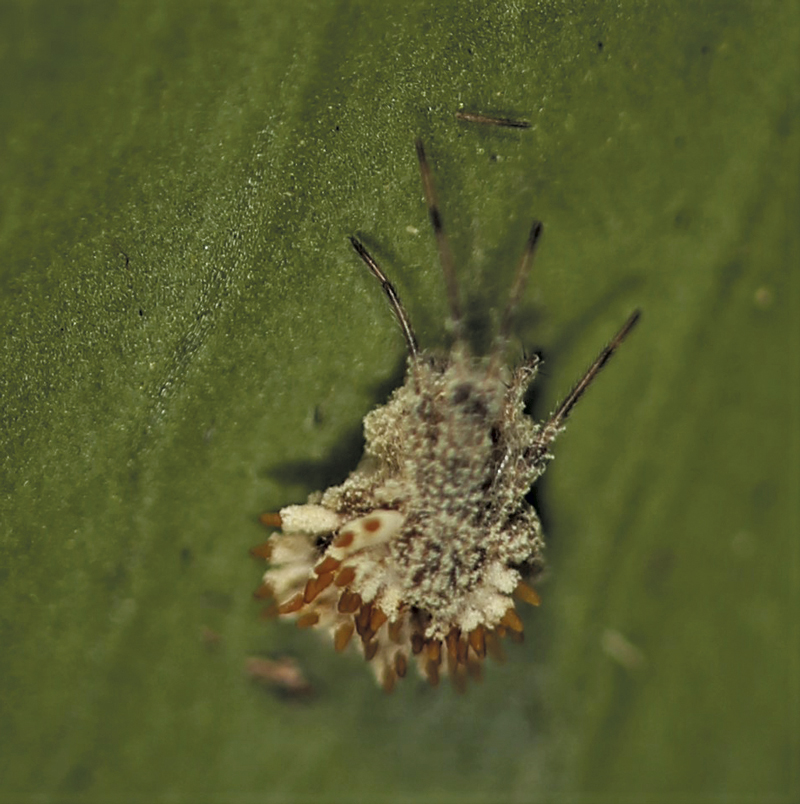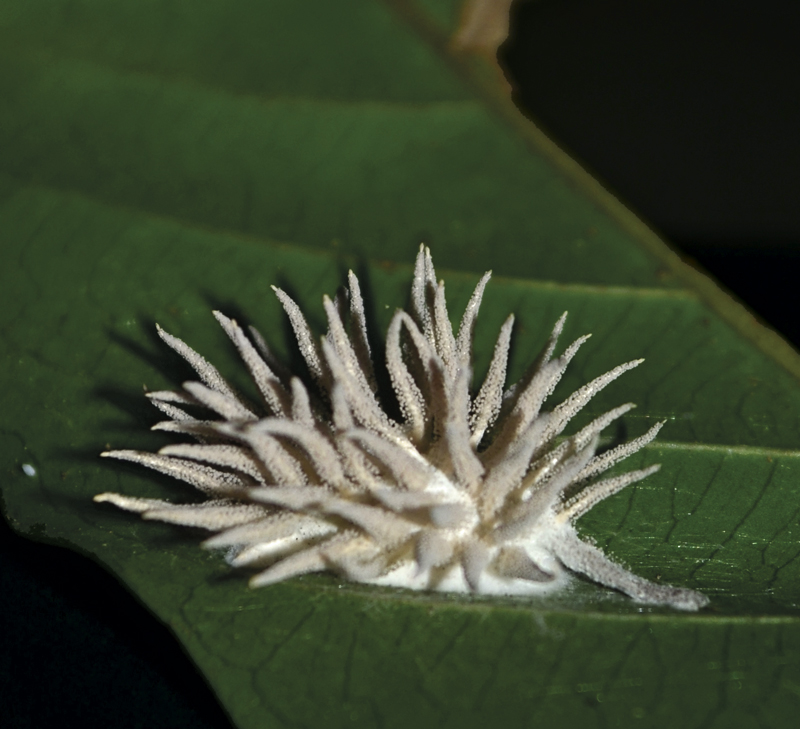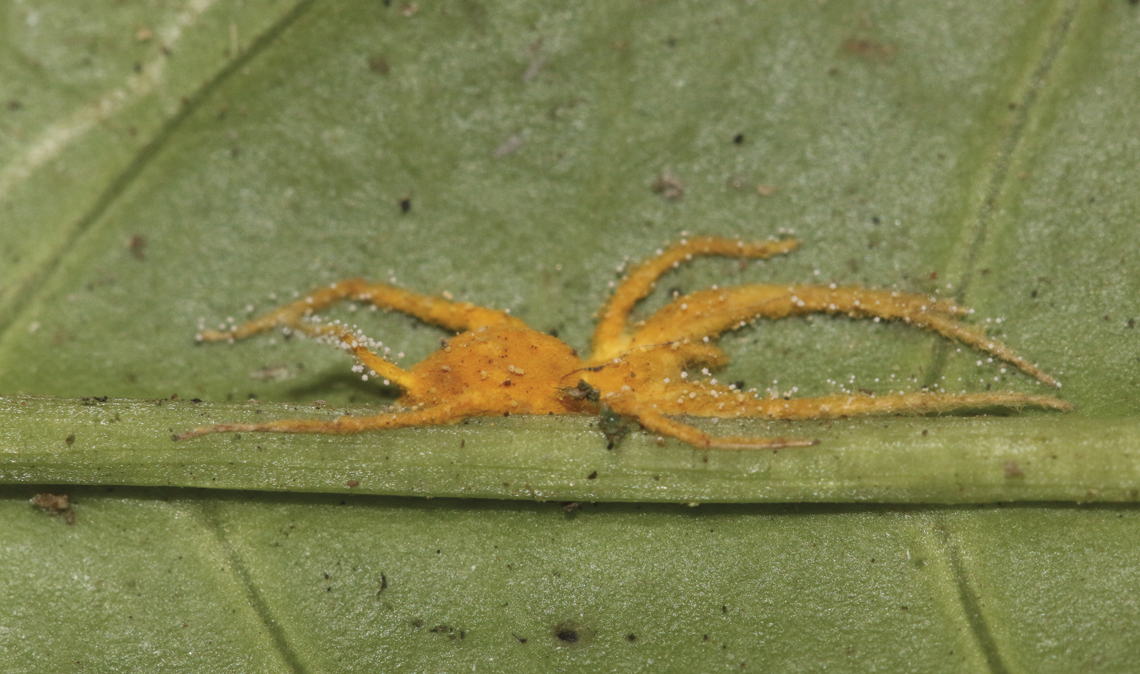In mid-forest tree foliage about 1 meter (m) off the ground, whitish stains may, at a distance, be taken for bird droppings. Upon closer inspection they are, in fact, velvety mounds, which at times carry the features of a spider that once lived, and at others take on minuscule, alien-like forms. These, then, are the reproductive structures of fungi that specialize in inhabiting spiders as parasites. A similar phenomenon in ants was the inspiration for The Last of Us, a computer game featuring ravenous creatures affected by a mutant fungus, which became a television series this year.
“The parasite manipulates the behavior of its hosts to confer a considerable advantage upon the fungus,” explains biologist Aristóteles Góes Neto, coordinator of the Laboratory of Molecular and Computer Biology of Fungi at the Federal University of Minas Gerais (UFMG). The manipulation generally causes the spiders to ascend the trees and settle on higher leaves than they normally would, to die there. “They are like real-life zombies,” quips the researcher. From this position the reproductive structures of the fungi release spores that fall in a shower of microscopic dust, scattering down to the next victims on lower leaves.

Jober Sobczak / Unila
With its genitalia destroyed, it can be impossible to identify a parasite-infested spiderJober Sobczak / UnilaIn April this year the group published a study into the parasite genus Gibellula in the Journal of Fungi, the doctoral research of biologist Thairine Mendes Pereira in her contribution to exploring the association. “This is one of the only fungus genera that exclusively inhabit spiders,” says Góes Neto. In addition to bibliographical research, the fieldwork involved a survey of vegetation in Rio Doce State Park, located in the southeastern state of Minas Gerais, and in the Santa Lúcia Biological Station and the Augusto Ruschi Biological Reserve, the latter two in the state of Espírito Santo.
The biologist also sought out parasite-inhabited spiders in northeastern state Ceará, in partnership with ecologist Jober Sobczak, of the University for International Integration of the Afro-Brazilian Lusophony (UNILAB). In the municipal area of Pacoti they identified a fungus which, on occupying the spider, coats it in gold-colored hyphae (fungus filaments), coining the name G. aurea, as described in a 2022 article in Phytotaxa. “It is difficult to identify the spider after the spores are formed because the fungus destroys the host’s body,” Sobczak elaborates. When it is possible to count the legs, the researchers can distinguish arachnids from insects, but more detailed identification of spiders usually depends on examination of their genitalia.
The phenomenon has been studied in depth in insects, but is still broadly unknown in respect of spiders. “This area of mycology [the study of fungi] is still very much uncharted, but a sizeable proportion of the research is being produced in Brazil through the work of professors Ari, of UFMG, and Jober Sobczak in Ceará,” says Brazilian mycologist João Araújo, curator of fungi at the New York Botanical Garden in the US. Araújo has collaborated with Brazil-based groups to describe species, define taxonomic connections between them, and elucidate their biology and evolution. “We are still taking baby steps in terms of understanding the real biodiversity in terms of these fungi.”

Thiago Kloss / UFV
It is difficult to discern the host on the underside of G. leiopus reproductive structuresThiago Kloss / UFVHe goes on to say that Brazil is home to some of the world’s most significant diversity of fungi with parasitic habits. “Amazonia and the Atlantic Forest are ‘goldmines’ for those studying these fungi,” he says. “Sometimes most of a day’s samples are of as-yet undiscovered species.”
Sobczak notes that findings in the Brazilian Northeast have made it clear that there is a forest-wide connection between the South and the North. “We have found the same fungus species associated to the same host in Ceará, Amazonas, and Vale do Ribeira between the states of São Paulo and Paraná,” he explains. The primary site for his research is the Baturité mountain range, an area of Atlantic Forest in northeastern Ceará in the middle of a region where semiarid scrubland (Caatinga) predominates. “We have discovered a high incidence of parasitism on the underside of leaves and on bromeliads,” reports the ecologist. “We have seen wasps, ants, beetles, and crickets—there is evidence of this being an area with a significant wealth of entomopathogenic [insect] and araneopathogenic [spider] fungi.”
Once the inventories are compiled, work begins on understanding the as-yet undefined mechanisms of action. The consistency in causes of death, however, evidences a likely adaptive advantage for the fungus. “Regardless of the species, all the spiders die in similar locations, stuck to the underside of leaves.” The researcher states that a study coordinated by him and conducted by ecologist Ítalo Arruda, from the Federal University of Ceará, provides convincing evidence that the fungus causes the spiders to climb to the highest vegetation. On average, the parasite-infested arachnids die splayed out on the leaves about 1 m off the ground, while those not affected spin their webs at a height of 75 centimeters, as described in a 2021 article in the Canadian Journal of Zoology.

Jober Sobczak / Unila
A Macrophyes pacoti spider coated in the gold-colored hyphae of G. aureaJober Sobczak / UnilaResearchers are yet to confirm exactly how the fungus advances through the spiders’ organisms after infection, but Góes Neto deduces that the process is similar to that observed and documented in insects, where the fungus produces compounds that act on the neurons of the invertebrates and alters their behavior. “We have sequenced the full genome of G. pulchra, the most widely distributed species of fungus, and found several genes possibly involved in attacking the nervous system,” he says of the ongoing work.
Republish